Every Tuesday, UI physician-scientist Kumar Narayanan steels himself as he bikes to work. It's the most challenging day of his week—the day he sees patients from across the state who are affected by Parkinson's disease.
Narayanan has to deliver the bad news to patients and their families that they have developed the neurological disorder, one that affects both motor and cognitive skills. One that has no cure.
"It's discouraging and dispiriting to tell person after person that they have Parkinson's. And it's not getting better," says Narayanan, an assistant professor of neurology who sees patients at UI Hospitals and Clinics. "The population of patients with Parkinson's disease is going to double by 2030 because people are living longer. This is a problem that we're going to have to solve, and will be the enduring challenge of our generation."
Making scientific breakthroughs in neuroscience, ones that could lead to novel treatments—even cures—for psychiatric and neurological disorders such as Parkinson's, is a major goal for researchers at the UI. And several campus initiatives are positioning the university to reach these objectives.
A new undergraduate major in neuroscience that launched this fall complements an already distinguished graduate program, preparing the next generation of scientists. A new psychological and brain sciences building to be completed in 2019 will modernize study in the rapidly evolving science of psychology, providing students and faculty with state-of-the-art classroom and laboratory space. Perhaps most significant in the university's commitment to neuroscience is the Iowa Neuroscience Institute.
Established in 2016 with a $45 million grant from the Roy J. Carver Charitable Trust and support from the UI Roy J. and Lucille A. Carver College of Medicine, the multidisciplinary center is comprised of more than 100 scientists across campus determined to solve the mysteries of the brain and nervous system. The institute has two floors of dedicated lab space in the Pappajohn Biomedical Discovery Building, which is adjacent to the UI Hospitals and Clinics on the west side of campus.
Leading the Charge
At the helm of the Iowa Neuroscience Institute is Director Ted Abel, an internationally renowned neuroscientist and fellow of the American Association for the Advancement of Science. He previously directed the Biological Basis of Behavior Program at the University of Pennsylvania, and wasted no time when he arrived at the UI in January 2017, recruiting a number of prominent scientists from across the country.
By building a collaborative team of researchers and securing vital resources, such as funding, research cores, and equipment, Abel aims to improve the lives of patients with disorders ranging from autism to Alzheimer's disease to stroke. Neurological diseases afflict more than 100 million Americans, according to a 2017 report published in the Annals of Neurology, straining families, burdening the health care system, and costing nearly $800 billion annually. "In other areas of medicine, doctors have been able to develop treatments that either delay disease, as in the case of heart disease, or treat those disorders, as in HIV," says Abel, whose research focuses on autism and how sleep enhances memory formation. "With the recent striking advances in our ability to image the function of neural circuits and to manipulate their activity, neuroscience is poised to make a difference with new insights into brain disorders."
That impact is something Abel has experienced firsthand. His teenage son has autism spectrum disorder, and his own research on the male predominance in autism has the potential to bring him—and the scientific community—one step closer to understanding the disorder, which affects an estimated 1 in 68 children in the U.S. In a recent study, Abel uncovered a hint: Male mice that model autism showed an impairment in reward learning, or the ability to associate a reward with a particular stimulus and response.
Abel recognizes that these discoveries will take a lot of effort, innovation, and likely some serendipity, but has little doubt that the UI will make a difference. "The gift from the Carver Charitable Trust is transformative in that it enables us to attract the best researchers and to pursue new frontiers and ideas in fundamental research," he says. "I'm confident the University of Iowa can be a game changer because we have the resources to do it and a collaborative community that is committed to it."
Collaborative Community
Members of the Iowa Neuroscience Institute represent 26 academic departments across five colleges and work on a number of thematic research areas ranging from epilepsy to molecular psychiatry to neuroimaging. These researchers bring in more than $50 million in annual external grant support. To encourage innovative and outstanding research, the institute allocated its first round of internal funding support in July 2017, awarding seven research teams $4.6 million over five years.
One of the recipients is Hanna Stevens, an assistant professor of psychiatry who runs the Psychiatry and Early Neurobiological Development Lab in the Carver College of Medicine. She researches the genetic and environmental factors that influence early brain development and how those factors may play a role in childhood behavior or influence the risk of psychiatric disorders.
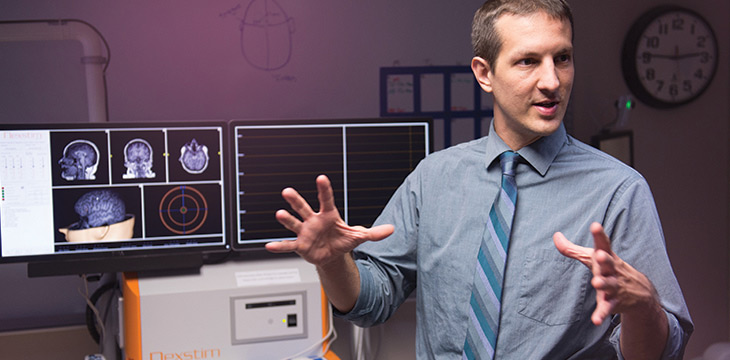 Aaron Boes, assistant neurology professor.
Aaron Boes, assistant neurology professor."Fundamental changes occur in the brain very early on that put a person at risk for psychiatric illness later in life," she says. "We need to understand what those factors are, so we can understand how the brain isn't operating correctly at the time of illness. We also need to find out what preventive measures we can introduce to protect the brain as it develops."
Stevens says being in such proximity to other scientists in the institute has benefited her research. When there is something she doesn't understand, whether it be related to molecular biology or data analysis or another area, help is available—and those consultations often bring insight and lead to collaboration.
"Collegiality really makes a huge difference in what we have the potential to do. It's natural for people here to consider, ‘How could we do this better together?'" says Stevens, who came to the UI in 2014 from the Yale School of Medicine. "That is what everybody is looking for in science—an innovative way to think about the questions you've been asking for a long time, an innovative way to help patients that we hadn't thought of."
For example, Joshua Weiner, a professor of biology in the UI College of Liberal Arts and Sciences, studies brain development at the molecular level. Though not directly targeting therapies, his lab's research has an important role.
"The human brain is probably the most complex thing in the universe, at least in biology. How do you get from a neural tube in an embryo that is one cell layer thick, a very simple structure, to a human brain with 100 billion neurons, each having maybe 10,000 connections or synapses with other neurons?" says Weiner, who recently received one of four $75,000 accelerator grants from the institute to support a new line of research in his National Institutes of Health–funded lab. "Ultimately, we're trying to get a better fundamental understanding of how this works, because these processes of neural development go awry in a variety of different disorders, such as autism, intellectual disability, and schizophrenia. In order to develop therapeutics, we need to understand the fundamental mechanisms through which neurons assemble these connections in the first place."
Aaron Boes, 03BS, 09MD, 09PhD, recently returned to his native Iowa from Harvard University to build on translational research pairing advanced neuroimaging and noninvasive brain stimulation. At UI Hospitals and Clinics, Boes works with patients who have medication-resistant depression. They receive transcranial magnetic stimulation (TMS) five times a week for four to six weeks, and more than half see an improvement. "Focally stimulating the brain using induced currents can have therapeutic effects," he says. "Though it's mostly used to treat depression, there's really no limit to the number of brain-based disorders it can treat."
The UI is one of only 20 research institutes in the U.S. with a 7 Tesla MRI research scanner on-site. The scanner produces high-resolution images of microscopic structures within the human body, allowing researchers to measure subtle changes in the size, function, and metabolism of specific brain structures associated with disease.
In addition to exploring ways to more effectively use and individualize this treatment, Boes oversees two clinical trials to determine whether patients with schizophrenia or bipolar disorder also could benefit from TMS. He says the Iowa Neuroscience Institute's recent purchase of additional TMS equipment will allow him and his colleagues to explore further applications. "It's one of the few areas where there is a relatively rapid turnaround in terms of understanding whether something is going to have the effect that you intend it to have," says the assistant professor of pediatrics, neurology, and psychiatry. "It's been an exciting area for research, and it's really at its infancy."
More Than the Sum
Narayanan is exploring the use of TMS to treat patients. In his research of Parkinson's disease, he studies ways to improve its detection, protect the circuits that degenerate as a result, and compensate for circuits that have already failed. "We think any progress we make on these three fronts will benefit patients with all neurodegenerative diseases, Alzheimer's, and frontotemporal dementia," says Narayanan. "It will also have benefits for patients with psychiatric diseases."
Narayanan looks forward to the day when he can deliver good news to his patients about treatments for Parkinson's disease. Neuroscientists working together at the UI, he says, will make a difference.
"Every person at the University of Iowa has multiple collaborations," says Narayanan. "This leads to innovative grants and papers, but also new ideas that enable us to be more than the sum of our parts."
A Groundbreaking Vision
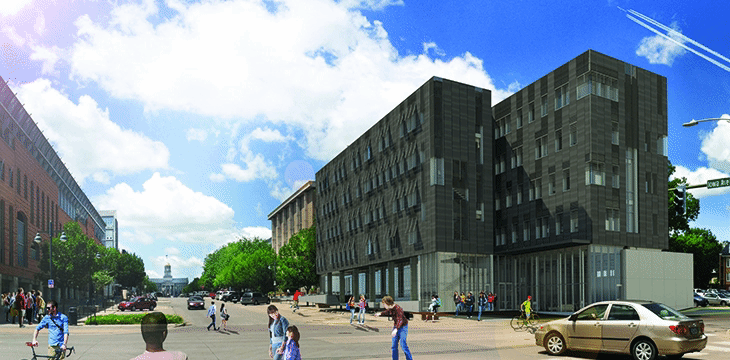 Artist's rendering.
Artist's rendering. Psychology has long been one of the most popular undergraduate majors at the UI, and it also boasts a sizable graduate program.
With the UI's renewed emphasis on neuroscience, faculty, staff, and students in the Department of Psychological and Brain Sciences soon will enjoy a new campus headquarters.
The department, which has more than 1,400 declared majors, is currently housed in three buildings near downtown Iowa City: Spence Laboratories, Stuit Hall, and Seashore Hall. The new six-story, 66,470-square-foot Psychological and Brain Sciences Building will be built to the east of Spence Labs—providing direct connections between the two buildings—and its construction includes razing a portion of Seashore Hall this winter. Funding for the project will come in part from donor gifts.
With completion tentatively set for 2019, the building will support the changing nature of the growing academic discipline by fostering collaborations across campus departments, such as biology, psychiatry, and neurology. "The new building will collect our faculty in one place and have state-of-the-art classrooms and cutting-edge labs, and—for the first time in anyone's memory—will provide commons space for our students," says Mark Blumberg, department chair and F. Wendell Miller Distinguished Professor. "We will be positioned to better prepare students for what modern psychology is all about."
Scope of Study
Thematic areas of neuroscience research at Iowa include:
Aging mind and brain and neurodegenerative diseases
Auditory neuroscience
Behavioral and cognitive neuroscience
Drosophila neurobiology
Epilepsy interoception and neural control of homeostasis
Molecular psychiatry
Neurogenetics
Neuroimaging
Neuromuscular research
Pain vision research
The Rise of Genetic Counseling
As a certified genetic counselor specializing in neurology, Shawna Feely supports patients waiting for test results that could drastically change their lives.
With increased understanding of the human genome, improvements in screening technology, and the popularity of direct-to-consumer DNA-testing services, the demand for counselors who can help navigate the genetic landscape has skyrocketed nationwide, whether in a clinical setting or in a research lab. This includes at the UI, where Feely is one of 20 genetic counselors serving both patients and physicians in specialty areas across the hospital.
Feely sees as many as 15 patients a day—many of whom have a family history of neurological disorders such as Huntington's disease, a progressive and incurable brain disorder. Working as part of a health care team, she guides patients through all phases of genetic testing, including the range of emotions that come with the results. "Finding out how you might die has implications for your life, from financial planning to family planning," says Feely. "We try to help people with the decision-making process by supporting them through education and emotional care."
Feely notes that patients should weigh several factors when deciding whether to test for the likelihood of developing a heritable disease, including what they'll learn from the test, what they'll do with the results, and whether having the results will improve their quality of life. "The sessions can get pretty heavy. There are a lot of emotions either way," says Feely, who notes the guilt that some patients have in being the only one of their relatives without a particular gene. "While we can't control the test results, we can guide the process—even determining which day of the week would be best for the patient to receive the results."
According to U.S. Bureau of Labor Statistics projections, employment of genetic counselors will grow by 28 percent between 2016 and 2026, faster than the average for all occupations. An estimated 4,000 genetic counselors currently work in the U.S. The UI does not yet have a graduate program in genetic counseling—establishing one is a long-term goal, Feely says—but it has assembled a team of genetic counselors with specialties in neurology, women's health, cancer, nephrology, pediatrics, and cardiology. Iowa also offers a competitive summer internship that gives college students and recent graduates an opportunity to shadow the UI genetic counselors and get hands-on experience in the field.
Although Feely says she could take a job anywhere, she and colleague Michael Shy, UI professor of neurology, pediatrics, and molecular physiology and biophysics, chose to relocate their clinic for patients with Charcot-Marie-Tooth disease, a group of inherited nerve disorders, from Wayne State University in Detroit to the UI. The collaborative atmosphere at Iowa was key, she says.
"Diseases don't happen in silos," Feely says. "We need to cross over and include others in care management to figure out how to effect change. If we work together, we can do that faster."
Nearly a Century Studying the Brain
The UI has a long, distinguished history of neuroscience education and scholarship:
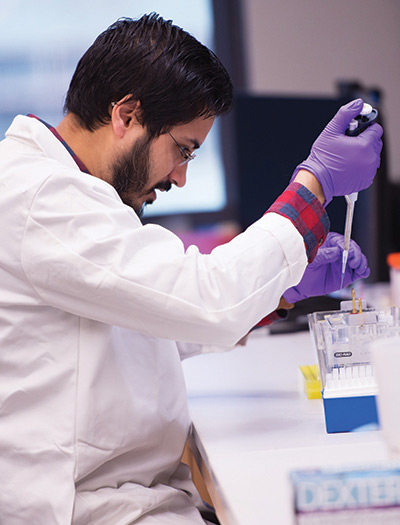 Scientist at work in Ted Abel's lab.
Scientist at work in Ted Abel's lab. The Carver College of Medicine's neurology department, founded in 1919, was one of the first academic departments of neurology in the country—and the first west of the Mississippi River. Former department chair Adolph Sahs, 31MD, was one of the founders of the American Academy of Neurology in 1947.
In 1919, the Iowa Legislature appropriated funds to build the Iowa Psychopathic Hospital on campus, with a focus on patient care, education, and research. Now housed in UI Hospitals and Clinics, it is believed to have been the first university-affiliated psychiatric department west of the Mississippi.
In the 1920s, the UI neurology department's residency program was one of the first to be accredited. According to Archives of Neurology, in 2011 the program ranked in the top 20 for the number of trainees that went on to careers as faculty members in academic neurology departments, and the top 10 for number of citations of their publications.
The growth of the UI neurology department during the 1970s and '80s attracted researchers like internationally renowned Antonio Damasio, a neurobiologist who eventually became the department's fourth chair and now is at the University of Southern California. His research led to a greater understanding of how the brain orchestrates higher-level cognitive functions such as language, memory, emotion, and decision-making, and helped explain how damage to particular brain regions affects
these functions.
The psychiatry department in the UI Carver College of Medicine is ranked No. 18 in NIH research funding, and faculty members have made significant contributions in understanding psychiatric disorders, such as schizophrenia, and applying neuroimaging techniques to study the brain.
In 1982, Damasio co-founded the Iowa Neurological Patient Registry with his wife, Hanna Damasio, a fellow neuroscientist now also at USC, and Daniel Tranel, 81MA, 82PhD, a graduate student at the time and now a UI faculty member and fellow of the American Association for the Advancement of Science. The one-of-a-kind registry has collected brain scans of thousands of patients, along with medical histories and lesion maps, and has 500 active members available to participate in cognitive research studies.
The Department of Psychological and Brain Sciences in the UI College of Liberal Arts and Sciences is one of the oldest and most distinguished psychology departments in the country. The UI also is home to the Human Brain Research Laboratory, one of 41 Huntington's Disease Society of America Centers of Excellence, the Iowa Neuroimaging Consortium, the Auditory Neuroscience Group, and many other researchers and physicians working to understand the mysteries of the brain and nervous system.
A Neuroscience Trailblazer
Nancy Andreasen, 70MD
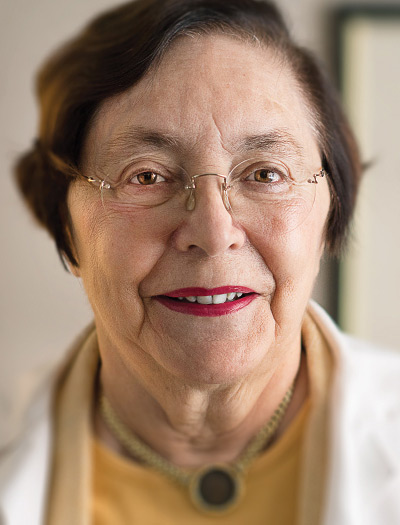
Nancy Andreasen's prominent career in neuroscience almost didn't happen.
The world-renowned researcher was teaching Renaissance literature on the UI's English faculty in the 1960s when a health scare after the birth of her first child prompted her to switch gears.
"I nearly died, and I decided that I really had to give back the life that I was given again and to try to do more for mankind," she says. "A medical career seemed to be a good way to do that."
Andreasen, who holds the Andrew H. Woods Chair of Psychiatry, is a pioneer in neuroimaging, having used MRI technology in the 1980s to show that schizophrenia is a disorder of the brain. She has written three books about the brain for the mass market, along with a dozen scholarly titles and more than 600 articles. She is the first woman to win the American Psychiatric Association's highest award for research, and in 2000 she received the National Medal of Science at the White House.
"I nearly died, and I decided that I really had to give back the life that I was given again and to try to do more for mankind."
- Nancy Andreasen
Nearly five decades after beginning her career in scientific discovery with a medical degree from the UI, Andreasen still conducts research at UI Hospitals and Clinics. "I just love the interdisciplinary nature of what I get to do. It's not focusing on one little thing—it's looking at really big, broad ideas," says Andreasen, 70MD, who completed the first empirical study that identified a link between creativity and mental illness. "The development of imaging technologies was a very exciting time in my career—we could actually see the brain and measure it—and it's been exciting ever since."
At the UI, Andreasen used neuroimaging to detect abnormalities in the brains of people with schizophrenia, which afflicts more than 3 million Americans. Now, she and her colleagues are researching how the disease progresses and whether it's different from brain-tissue loss in people without the disease.
"The goal is to find out what the mechanism is behind those brain changes and then to figure out how to attack that with medication or some other means," Andreasen says. "Schizophrenia is a terrible disease, and we really need to have better treatments so that people with that illness can have more normal lives."
Andreasen says she studied the brain "because it is the most interesting organ in the body" and schizophrenia, in particular, "because it's the illness within psychiatry that has the greatest disruptions in brain function." She didn't shelve her interest in literature, however.
In addition to her longitudinal research on schizophrenia, Andreasen has continued her study of creativity, in one project interviewing Kurt Vonnegut and other members of the Iowa Writers' Workshop, the country's No. 1 creative writing program. She has expanded that research to include scientists and artists such as filmmaker George Lucas.
"Is the creative process the same in the arts and sciences? Although the study is not done yet, I've pretty much concluded that they are not separate things. The creativity of a writer or a painter or an astrophysicist or a neuroscientist seems to have the same roots," says Andreasen, whose research on creativity was featured in The Atlantic and on PBS NewsHour in 2014. "This diverse group of creative people also has a higher rate of mental illness. That's important to note because being able to say 'This collection of Nobel Prize winners and other famous people in the arts has more mental illness' helps reduce stigma."
Informing her work as a scientist, says Andreasen, is her education in the liberal arts and sciences. "I think a background in the humanities, particularly in something historical like Renaissance lit, really helps you see the big picture, to look into the future in a way that many other people can't," she says. "I think it's also made me a bit more humane than some scientists. I get very upset about the way that mental illness is stigmatized. It's cruel because these are diseases of the brain and the people who have them can't help it."
UI psychiatry professor Hanna Stevens says Andreasen's forward thinking and advocacy were responsible for major progress in understanding psychiatric diseases. "Andreasen has been a champion of people with mental health problems," says Stevens, who runs the Psychiatry and Early Neurobiological Development Lab in the Carver College of Medicine. "She has been amazing at advancing our field in general, of making people understand that psychiatry is a problem of brain development and brain functioning, and that psychiatric disorders are not a problem that you can just snap yourself out of if you want to. They are a problem of fundamental biology in the brain."
Andreasen says she has been heavily recruited by other institutions throughout her career, but she's had no interest in leaving the state or the university. "I've trained a lot of younger people, many of whom have stayed on here," she says. "It's as if I'm the mother of a large family, and I get great joy seeing their careers progress. It's a loving place to be."
Major News for Undergrads
Start them while they're young.
That's one of the philosophies behind the UI's new undergraduate major in neuroscience. With more people equipped at an earlier age to critically study the brain, advances in understanding the most complex human organ may come quicker.
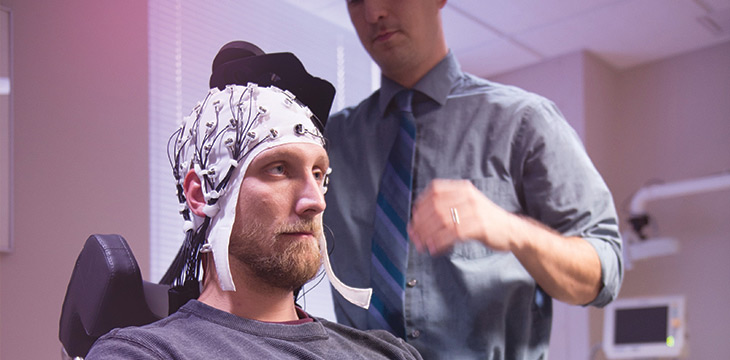 Assistant neurology professor Aaron Boes (right) studies the link between brain structure and function across lifespan.
Assistant neurology professor Aaron Boes (right) studies the link between brain structure and function across lifespan.The idea to start such a program on the UI campus took flight in 2016 with the establishment of the Iowa Neuroscience Institute funded by the Roy J. Carver Charitable Trust. Seventy-two students declared the major in fall 2017, the first semester it was offered. Majors will earn a bachelor of science in neuroscience from the UI College of Liberal Arts and Sciences. The program is administered jointly by the biology department and psychological and brain sciences department, and the Iowa Neuroscience Institute will provide support.
"Creating this major enables students to explore their interest in the brain and behavior and connect to a wider community of researchers and clinicians across campus," says Iowa Neuroscience Institute Director Ted Abel, who works with undergraduate researchers in his lab to study the role of sleep in memory storage. "Undergraduate students often ask broad and insightful questions that help neuroscientists see new perspectives on challenges in the field."
In its first round of funding, the Iowa Neuroscience Institute awarded total of $4.6 million to seven research programs of excellence as well as $75,000 each in accelerator grants to four researchers.
The neuroscience curriculum includes required classes in behavioral, cognitive, and cell and molecular neuroscience; as well as in animal physiology, research methods, and data analysis. Coursework also spans across disciplines such as psychology, biology, chemistry, physics, calculus, and engineering to give students a broader view of the field. Ryan LaLumiere, associate professor of psychological and brain sciences and director of the neuroscience major, says, "While graduate study in neuroscience is much more specialized, students in our undergraduate program are exposed to the full breadth and range of neuroscience study at a younger age, and that's key to seeing the big picture."
The UI program is also set apart by the opportunities it provides undergraduates to do honors research in the labs of Iowa Neuroscience Institute faculty members. Ashton Thompson, a sophomore from Sioux City, Iowa, who sought a job in the lab of biology professor Joshua Weiner her freshman year, was among the first students to declare a neuroscience major. "I was really excited when I heard about the major," says Thompson, who previously planned to major in biology and psychology. "The neuroscience major combines all the good parts of those two areas and makes them one cohesive curriculum."
Weiner says recent advances in brain imaging and genetics make it an exciting time to study neuroscience. "Neuroscience is considered by many to be one of the last frontiers of science," says Weiner, who also acts as the Iowa Neuroscience Institute's associate director for education and outreach. "We still don't know how the mind and brain work to create cognition, and it's important to give undergraduates the opportunity to focus on that."
For more, visit uiowa.edu/stories/breaking-barriers-brain-research.

